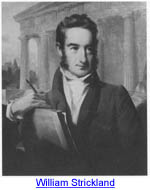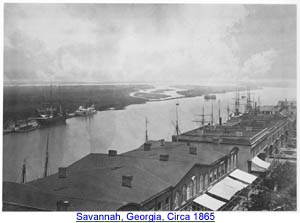

 Unique, "EB on Breast"
Unique, "EB on Breast"1787 Brasher Doubloon from
The Gold Rush Collection
The Mint Construction
The mint building was to be constructed to the same plans as the Charlotte Mint. The architect was William Strickland, who was well known in his day as a proponent of the Greek Revival style.
 The basic outline of the building was that of a block letter "T," with the top of the "T" comprising the front wing. The front was to be 125 feet by 33.5 feet, while the stem of the "T" measured 53 feet in length and 36 feet in width, although evidence indicates that the front was actually constructed to a length of 127.5 feet. A building site was selected on a hill close to the town square. The 27-room structure was to have first and second stories composed of brick, covered with stucco and grooved to simulate the large granite block of the basement foundation.
The basic outline of the building was that of a block letter "T," with the top of the "T" comprising the front wing. The front was to be 125 feet by 33.5 feet, while the stem of the "T" measured 53 feet in length and 36 feet in width, although evidence indicates that the front was actually constructed to a length of 127.5 feet. A building site was selected on a hill close to the town square. The 27-room structure was to have first and second stories composed of brick, covered with stucco and grooved to simulate the large granite block of the basement foundation.
The remote location caused a gamut of associated construction problems. One would not expect to find skilled workmen and quality building materials in such a backwoods community, but the failure of the mother mint at Philadelphia to foresee and compensate for these problems only aggravated the situation. For example, the problems encountered with the making of brick could have been easily avoided by specifying granite or limestone, which were regional specialties.
Other construction problems were compounded by the fact that Commissioner Few was not a model taskmaster, making only an occasional inspection of the activities. One of Few's detractors described his efforts as commissioner, "He is labouring (sic) under permanent ill health from rupture of the lungs...all energy appears to have left him & his business habits (if ever he had any) has (sic) certainly escaped. He appears very laudibly (sic) & we may say entirely devoted to the affairs of another and better world & should be left quietly to their contemplation."
Juxtaposed with the rusticity of the community in which it was to operate, the mint was to be supplied with the latest in automated coining equipment. The most revolutionary were two steam presses, invented by Franklin Peale, a mainstay at the Philadelphia Mint, based on his recent observations in Europe, and first incorporated in the primary mint in 1836. The presses were probably the "small" version, rendering them incapable of producing coins larger than a half eagle. The presses, and other associated equipment, were shipped in 15 boxes to Savannah, sent upriver to Augusta, then hauled overland by wagon to Dahlonega.

Due to reports of the construction difficulties reaching Philadelphia, the primary mint dispatched its crack troubleshooter, Franklin Peale, who arrived in Dahlonega in November 1837, along with his daughter, after inspecting the Charlotte facility. Close scrutiny of the Dahlonega Mint edifice revealed many problems, the blame for which Peale assigned to "ignorance on the part of the contractor and the drunken and bad habits of the workmen." The longer Peale remained in Dahlonega, the worse his assessment of the building's condition became. The somewhat rambling description which follows accurately conveys Peale's exasperation at the situation: "The workmanship of the Mint edifice is abominable, a letter might be three times filled with the details of errors and intentional mal (sic) constructions, the first and greatest of which may fairly be traced to Philadelphia, in ordering a brick building in a country where there is no clay, the material employed for the brick making being the red soil of the Gold region, a decomposed granite . . . put into Brick by men who certainly deserve diplomas for Botching. " The other major problems noted by Peale included a plaster cornice (instead of the specified brick), a leaky zinc roof, and defective first floor arches (which were subsequently abandoned). Although the building was not finished and personnel were "dodging from room to room" in rainy weather, Superintendent Singleton decided that the mint was ready to begin coinage operations in February 1838.